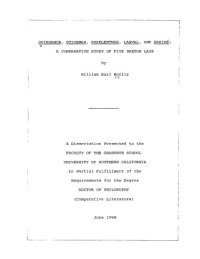
Ebook: Guingamor, Guigemar, Graelentmor, Lanval, and Desiré: A Comparative Study of Five Breton Lays
Author: William Earl Moritz
- Year: 1968
- Publisher: University of Southern California
- Language: English
- pdf
This study began with an attempt to analyze a single Breton Lay, Le Lay de Guingamor, but it soon became clear that no treatment of this particular lay would be complete without discussions of two other topics which have been the source of almost all the critical interest Guingamor has received: the nature of the Breton Lay as a genre, and the relationship between Guingamor and four other lays — Guigemar, Graelentmor, Lanval and Desiré — which share with it certain names, incidents, and phrases.
The focus of critical attention on both of these issues has been the question of originality. A twelfth-century Anglo-Norman poet usually called Marie de France is universally accepted as the author of, among other works, a collection of twelve Breton Lays which appear together in one manuscript with a prologue dedicating these lays to an unnamed king.
Of the group of lays analogous to Guingamor two — Lanval and Guigemar — appear in Marie's collection, and the other three — Guingamor, Graelentmor, and Desiré — are anonymous. In view of the fact that the artistry of Marie's lays is highly respected, various scholars have tried to prove either that Marie also wrote Guingamor, or that all the anonymous lays, including Guingamor, are merely pale imitations of Marie's lays.
These issues have been widely treated, and the present study has no new evidence to offer, but it does offer a new approach to the material — an approach suggested by Eugène Vinaver in his address Form and Meaning in Medieval Romance. Vinaver observes that critics have been prone to handle medieval literature either as historical documents useful as evidence of social, political, and linguistic phenomena, or as literary works which fail to comply with
the standards established by the "New Criticism." To remedy this, Vinaver calls for a new awareness that, though the particulars of taste may change, men of all ages have been intelligent and sensitive; therefore, Vinaver concudes, it behooves us to find the ways in which a given work may have been meaningful in its day, regardless of our currently favored fashions in literary styles.
This study, attempting to use a method compatible with Vinaver's principles, will survey the criticism on Guingamor, finding that no previous work has adequately I treated this poem as literature in its own right rather than as an analogue or derivative of other works. Then, in the second chapter, the very idea of attempting to discriminate between various Breton Lays on the mere basis of resemblances in plot and phraseology will be attacked by investigating the nature of the Breton Lay as a genre. Finally, in the third and fourth chapters, the five lays of the
Guingamor group will be analyzed, and on the basis of this literary appreciation, the study will try to determine
whether any of these three anonymous lays might be by Marie de France.
The focus of critical attention on both of these issues has been the question of originality. A twelfth-century Anglo-Norman poet usually called Marie de France is universally accepted as the author of, among other works, a collection of twelve Breton Lays which appear together in one manuscript with a prologue dedicating these lays to an unnamed king.
Of the group of lays analogous to Guingamor two — Lanval and Guigemar — appear in Marie's collection, and the other three — Guingamor, Graelentmor, and Desiré — are anonymous. In view of the fact that the artistry of Marie's lays is highly respected, various scholars have tried to prove either that Marie also wrote Guingamor, or that all the anonymous lays, including Guingamor, are merely pale imitations of Marie's lays.
These issues have been widely treated, and the present study has no new evidence to offer, but it does offer a new approach to the material — an approach suggested by Eugène Vinaver in his address Form and Meaning in Medieval Romance. Vinaver observes that critics have been prone to handle medieval literature either as historical documents useful as evidence of social, political, and linguistic phenomena, or as literary works which fail to comply with
the standards established by the "New Criticism." To remedy this, Vinaver calls for a new awareness that, though the particulars of taste may change, men of all ages have been intelligent and sensitive; therefore, Vinaver concudes, it behooves us to find the ways in which a given work may have been meaningful in its day, regardless of our currently favored fashions in literary styles.
This study, attempting to use a method compatible with Vinaver's principles, will survey the criticism on Guingamor, finding that no previous work has adequately I treated this poem as literature in its own right rather than as an analogue or derivative of other works. Then, in the second chapter, the very idea of attempting to discriminate between various Breton Lays on the mere basis of resemblances in plot and phraseology will be attacked by investigating the nature of the Breton Lay as a genre. Finally, in the third and fourth chapters, the five lays of the
Guingamor group will be analyzed, and on the basis of this literary appreciation, the study will try to determine
whether any of these three anonymous lays might be by Marie de France.
Download the book Guingamor, Guigemar, Graelentmor, Lanval, and Desiré: A Comparative Study of Five Breton Lays for free or read online
Continue reading on any device:

Last viewed books
Related books
{related-news}
Comments (0)